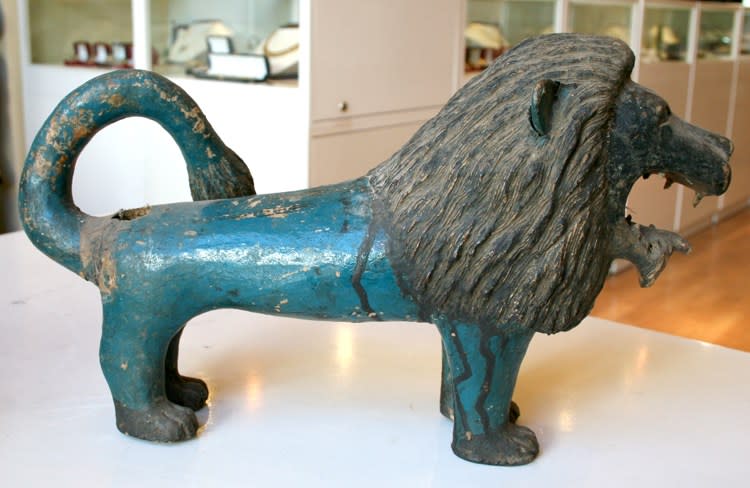Colonial Baule Painted Woode, 20th Century CE
Wood
5 x 9.5 x 16
CK.0820
The Baule live across the Ivory Coast area, and have an economy based primarily on sedentary agriculturism. They have thus been able to build up a considerable political and economic...
The Baule live across the Ivory Coast area, and have an economy based primarily on sedentary agriculturism. They have thus been able to build up a considerable political and economic stronghold, which has in turn given rise to a strong ritual and artistic heritage. Their own creation story relates to an ancient migration, in which the queen was forced to sacrifice her son in order to ford a mighty river. So upset was she that all she could say was “baouli” (“the child is dead”), thus giving rise to the tribe’s name.
Blolo bian (male) and Blolo bla (female) spirit spouses are perhaps the Baule’s greatest artistic and psycho- social achievement. These figures are otherworldly partners for young men and women, and are designed as perfect women/men who provide spiritual assistance to their earthly spouses. The Baule are also known for sculptures representing bush spirits (Asie usu) – mischievous and potentially malevolent inhabitants of the “bush”, or dark country beyond the boundary of the village – monkeys, and three types of masks that are used in the celebration of good harvests, mourning, and the visits of important dignitaries.
The lion is a symbol of strength and ferocity. The largest of the cat family, this animal is known as the “king of the beasts.” They are equally feared and respected for their power, speed, and intimidating growl. Kings and rulers have associated themselves with this noble creature since the earliest days of history. Perhaps this sculpture is too a royal symbol. A disproportion emphasis has been placed on its head, and more specifically on the bushy mane, sharp fangs and pointed ears. The piece has been painted in a bright blue color, a pigment likely brought into the region through Colonial trade.
Blolo bian (male) and Blolo bla (female) spirit spouses are perhaps the Baule’s greatest artistic and psycho- social achievement. These figures are otherworldly partners for young men and women, and are designed as perfect women/men who provide spiritual assistance to their earthly spouses. The Baule are also known for sculptures representing bush spirits (Asie usu) – mischievous and potentially malevolent inhabitants of the “bush”, or dark country beyond the boundary of the village – monkeys, and three types of masks that are used in the celebration of good harvests, mourning, and the visits of important dignitaries.
The lion is a symbol of strength and ferocity. The largest of the cat family, this animal is known as the “king of the beasts.” They are equally feared and respected for their power, speed, and intimidating growl. Kings and rulers have associated themselves with this noble creature since the earliest days of history. Perhaps this sculpture is too a royal symbol. A disproportion emphasis has been placed on its head, and more specifically on the bushy mane, sharp fangs and pointed ears. The piece has been painted in a bright blue color, a pigment likely brought into the region through Colonial trade.
